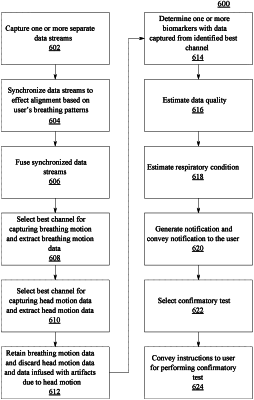| CPC A61B 5/0816 (2013.01) [A61B 5/1135 (2013.01); A61B 5/7221 (2013.01); A61B 5/7225 (2013.01); A61B 5/7285 (2013.01)] | 17 Claims |

|
1. A method, comprising:
capturing, with a selected portable device, a plurality of signals generated by a plurality of sensors of a plurality of portable devices including the selected portable device, wherein the plurality of sensors are positioned to sense different portions of a human user's body, wherein the plurality of sensors generate the plurality of signals in response to sensor-detected movements of the different portions of the user's body measured along multiple axes, the movements corresponding to lung activity in the user's body during one or more respiratory cycles;
selecting, using signal processing performed by a signal processor embedded in the portable device, a preferred axis of measurement from among the multiple axes;
filtering, with the signal processor, waveforms generated by signals selected from among the plurality of signals, wherein the selected signals correspond to signals generated in response to movements of the different portions of the user's body measured along the preferred axis of measurement;
within the selected portable device, time-aligning the waveforms corresponding to the plurality of portable devices and as filtered to adjust for drift of clocks of the respective plurality of portable devices, wherein the time-aligning is based on an iterative comparison of a window of the waveform of the selected portable device against the waveform of other ones of the plurality of portable devices;
extracting from the waveforms, using the signal processor, a biomarker corresponding to each of the different portions of the user's body indicating the lung activity and, based on a breathing synchrony between the biomarkers of the different portions of the user's body, determining a respiratory condition of the user; and
generating a notification based on the respiratory condition as determined.
|